How an American billionaire predicted — and then profited from — an Oxycontin 'prescription blizzard'
Clarification: A previous headline for this article stated that Dr. Richard Sackler predicted the U.S. opioid epidemic. We've changed the headline to reflect that Dr. Sackler's 1996 speech specifically predicted only the rapid rise of Oxycontin prescriptions.
The opioid crisis has ravaged through the U.S., taking hundreds of thousands of lives and costing the country an estimated $37 billion.
Nearly 400,000 people died from an opioid overdose between 1999 and 2017, according to the Centers for Disease Control (CDC), and the number of overdose deaths tied to opioids was six times higher in 2017 than it was eight years prior. An average of 130 Americans died every day of an opioid overdose in 2017, according to CDC data.
Much of the blame has been placed on pharmaceutical giants for aggressive marketing of prescription opioids and the FDA for lack of regulation. And certain companies made big money off the opioid boom — perhaps most notably OxyContin-maker Purdue Pharma.
‘The prescription blizzard will be so deep, dense, and white…’
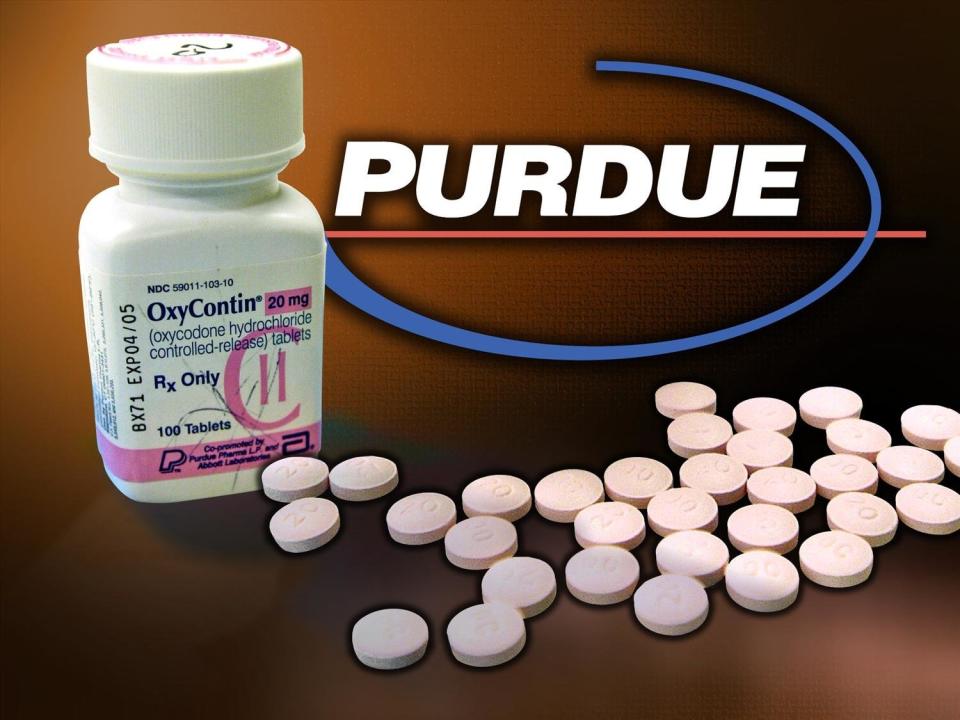
Purchased by Dr. Raymond Sackler and his brother Mortimer Sackler in 1952, the company that would become Purdue Pharma started as a NYC-based pharmaceutical firm and evolved into a family-owned behemoth over the next few decades. The company’s big break came in 1995 when the FDA approved its drug OxyContin, the first formulation of oxycodone with dosing every 12 hours instead of every 4 to 6 hours.
Dr. Richard Sackler, Raymond’s son and a Purdue Pharma board member, told a 1996 OxyContin launch party to “imagine a series of natural disasters: an earthquake, a volcanic eruption, a hurricane, and a blizzard,” according to the New York State Attorney’s lawsuit against Purdue Pharma.
“He said: ‘the launch of OxyContin Tablets will be followed by a blizzard of prescriptions that will bury the competition. The prescription blizzard will be so deep, dense, and white…’”
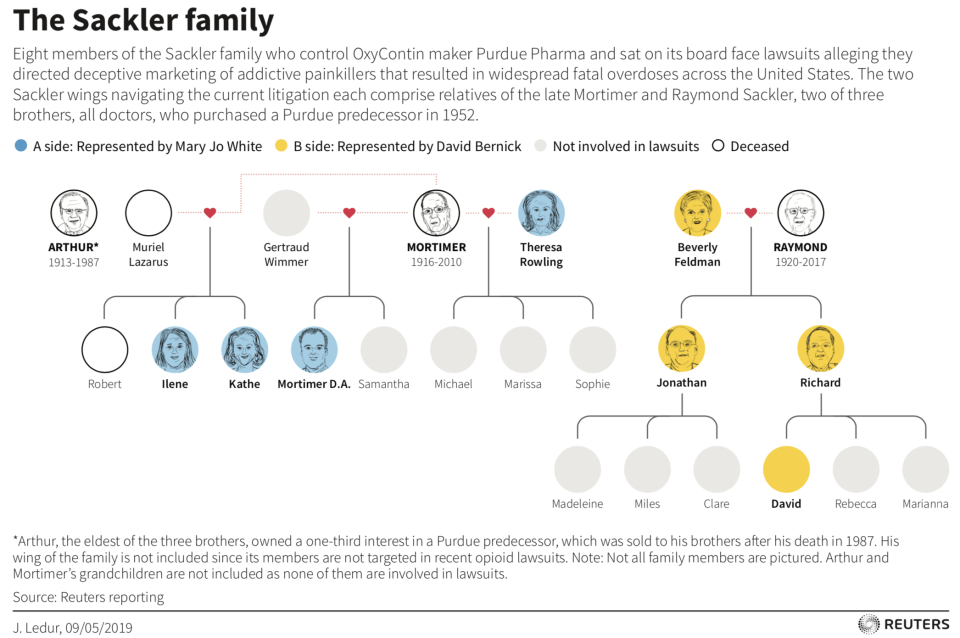
Over the next two decades, that prescription blizzard coincided with a growing U.S. opioid epidemic.
“Dr. Sackler used this much-quoted phrase in a speech given at the launch of OxyContin because the airports were closed following the historic blizzard of 1996, and he was a day late to the meeting as a result,” David Bernick, an attorney for the Sackler family, said in a statement to Yahoo Finance, adding: “The enthusiasm of Dr. Sackler’s speech also was totally understandable” given the recent FDA approval of the new drug.
‘Purdue Pharma vigorously denies the allegations’
After pleading guilty to criminal charges in 2007 related to fraudulently marketing of OxyContin from late 1995 to 2001, the Sackler dynasty’s company is now being taken to court in civil cases across the country.
In March, Purdue Pharma reached a $270 million settlement with the state of Oklahoma — and that was just the beginning.
As of June 12, 48 states and D.C. filed lawsuits against the company. The Pennsylvania lawsuit was blunt: “Simply stated, Purdue took advantage of addiction to make money.”

In a statement to Yahoo Finance, a Purdue spokesman highlighted that a North Dakota judge dismissed the state’s suit against the company on the grounds that "Purdue cannot control how doctors prescribe its products and it certainly cannot control how individual patients use and respond to its products, regardless of any warning or instruction Purdue may give.” North Dakota Attorney General Wayne Stenehjem said the state will appeal the dismissal.
“Purdue Pharma vigorously denies the allegations contained in litigation against the company and will continue to defend itself against these misleading attacks,” the Purdue statement added. “These sensationalized claims are part of a continuing effort to try these cases in the court of public opinion rather than the justice system...
“The recent decision by the North Dakota Court to dismiss all the claims filed by the Attorney General of North Dakota against Purdue is a significant legal victory for the Company that has potential far-reaching ramifications for both the state lawsuits and the claims pending in the multi-district litigation (MDL).”
The New York lawsuit alleges that seven members of the Sackler family, along with four entities and the other defendants, were “entrusted under New York law with critical roles in preventing the misuse and diversion of controlled substances [and] deliberately betrayed those duties through a persistent course of fraudulent and illegal misconduct, in order to profiteer from the plague they knew would be unleashed.”
The suit further alleges that “since 1999, the scourge of opioid addiction unleashed by the Defendants in this action has taken nearly 400,000 lives.”
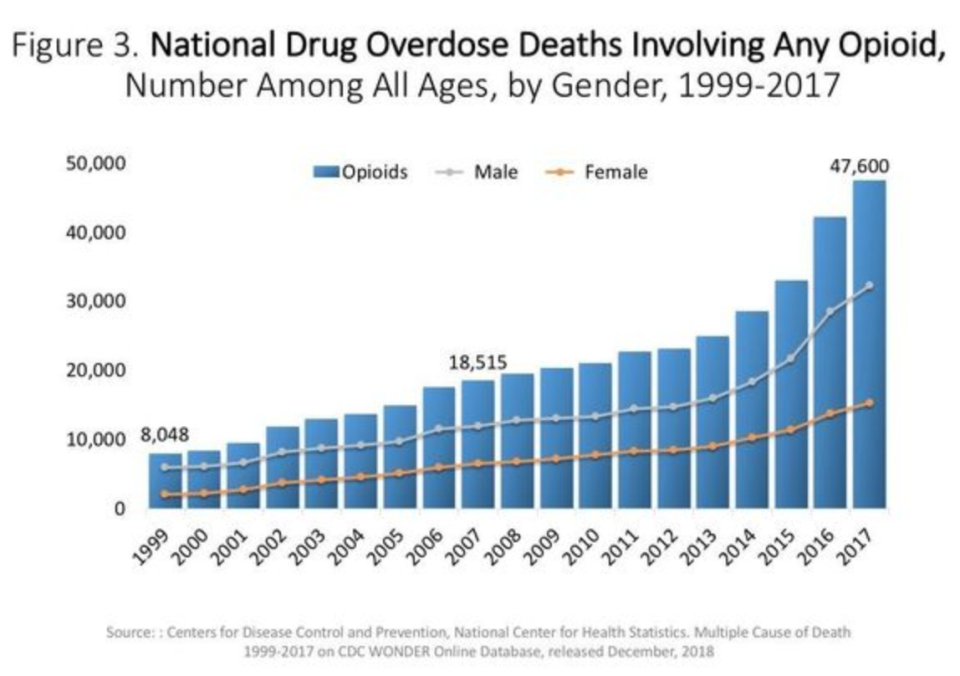
And as time goes on, more is known about Purdue’s role in the epidemic.
“There’s actually increasing amounts of evidence that’s coming out of the woodwork, in part through the multi-district litigation that’s particularly damning to Purdue,” Rebecca Haffajee, a former lawyer and assistant professor of health management and policy at the University of Michigan, told Yahoo Finance.
“There’s a couple of reasons for that,” she continued. “There seems to be … more coming out that there was an understanding of the addictiveness of their opioids, and particularly Oxycontin — that they were manufacturing and selling, then very deliberate trying to market those products to high prescribers, and using very savvy marketing techniques to try to really promote the prescribing of that substance.”
The statement from Bernick, the Sackler family attorney, asserted that Purdue Pharma ceased any questionable marketing practices in 2001. (In 2007, Purdue and three executives pleaded guilty in federal court to criminal charges of misleading the public about OxyContin’s addiction risks between 1995 and 2001.)
‘We were directed to lie’
In New York, Purdue is accused of using aggressive, sophisticated marketing strategies in addition to “an army of sales representatives and unbranded ‘patient advocacy’ websites” to change opioid prescribing norms into the 2000s.
“The scheme was spectacularly successful,” the suit stated. “From 2000 through 2011, the number of prescriptions for the Manufacturer Defendants’ opioid drugs more than quadrupled nationwide, even though there was no scientific basis for any significant increase in opioid treatment as medically necessary or appropriate.”
A Massachusetts lawsuit against the company states that “Purdue’s most powerful tool of deception was sending sales representatives to promote opioids to Massachusetts doctors, nurses, and pharmacists face to face.” In the map below, red indicates communities throughout the state of Massachusetts where Purdue promoted opioids since 2007.

Chad Brummett, an associate professor of anesthesiology at the University of Michigan and the co-director of Michigan OPEN, has studied how prescribers have been influenced as it relates to surgery and dentistry.
“We know that over time in the mid-’90s, when we saw that big uptick in prescribing, the influence went well past cancer pain and chronic pain,” he told Yahoo Finance. “It certainly spilled into acute pain for both surgery and dentistry.”
Between 21%-29% of patients who are prescribed opioids for chronic pain misuse them, according to recent U.S. government data, and between 8%-12% develop an opioid use disorder.
“The consistent theme you hear is that... [doctors] increased their prescribing during that time when opioids were considered a mainstay of care,” Brummett said. “They didn’t necessarily notice that patients were doing better, but certainly felt pressured to prescribe more. I believe based on what’s been released … that influence from the pharmaceutical companies certainly had an influence on prescribing for surgeons and dentists.”
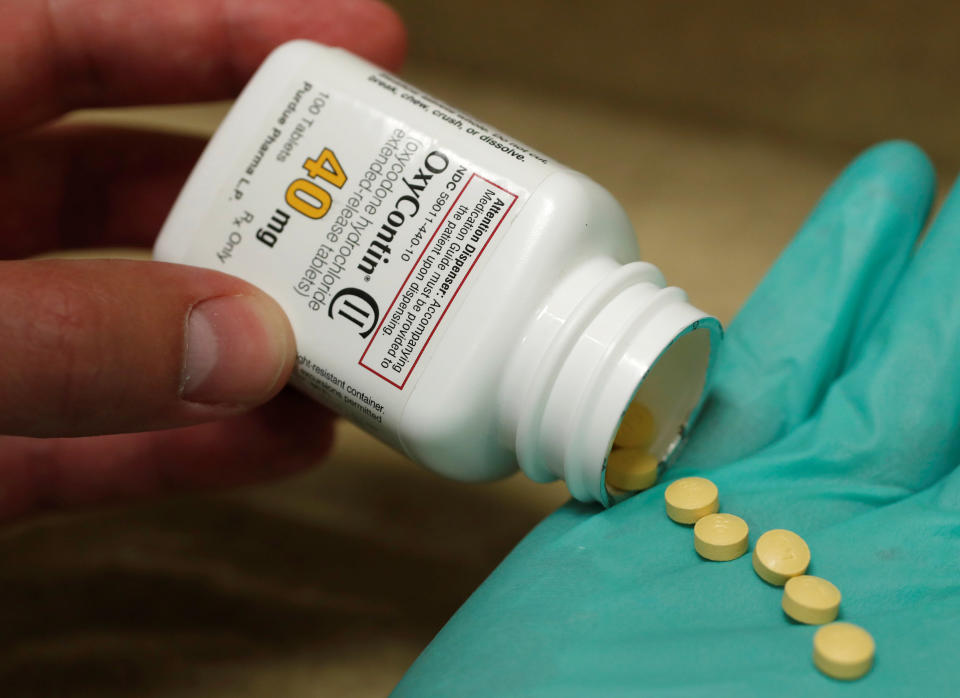
New York accused Purdue of using sales representatives to use “messaging and materials” that were approved of by the company. In doing so, Purdue “distorted the benefits and risks of ER opioids. As a sales representative told a reporter: ‘We were directed to lie. Why mince words about it?’”
“The pharma industry was aware that the [pain management reform] movement existed and put enormous money behind the people pushing for it,” David Herzberg, associate professor of history at State University of New York at Buffalo, previously told Yahoo Finance. “What you had was an FDA that was told to get out of the way of the industry.”
‘A lot of this money needs to go towards treatment, access to treatment, and future research’
There are indications that lawsuits and enforcement are helping combat the crisis.
President Donald Trump signed opioid legislation in October 2018 that created a federal task force. That task force, the Appalachian Regional Prescription Opioid Strike Force, arrested 60 people on April 17 — including 53 medical professionals linked to roughly 350,000 prescriptions and 32 million pills.
And on April 23, former Rochester Drug Co-Operative (RDC) CEO Laurence Doud III was charged with conspiracy to distribute controlled substances and conspiracy to defraud the U.S. Doud’s lawyer said that his 75-year-old client, who retired in 2017, was being scapegoated and would fight the charges.
“This prosecution is the first of its kind,” U.S. Attorney for the Southern District of New York Geoffrey Berman stated. “Executives of a pharmaceutical distributor and the distributor itself have been charged with drug trafficking — trafficking the same drugs that are fueling the opioid epidemic that is ravaging the country.”
At the time, a company spokesman stated that “RDC understands that these mistakes, directed by former management, have serious consequences. We accept responsibility for those mistakes. We can do better, we are doing better, and we will do better.”
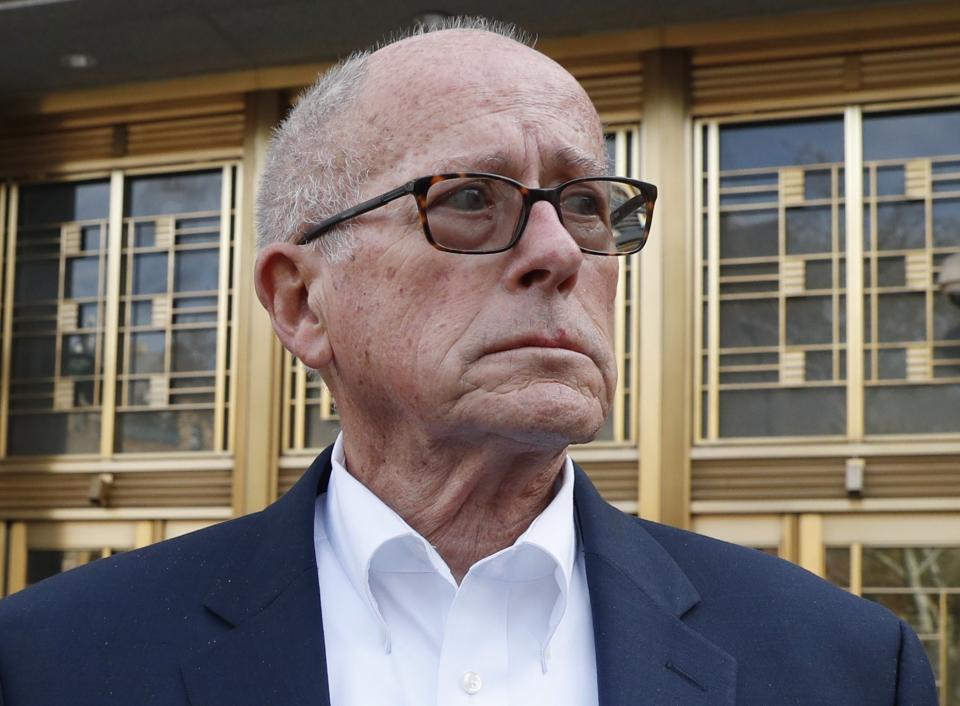
Drugmakers are facing financial strain from the litigation. In March, Purdue CEO Craig Landau told the Washington Post that the company is considering bankruptcy in the face of legal costs. On June 10, Insys Therapeutics filed for bankruptcy amid mounting legal costs from a federal probe allegations that it bribed doctors to prescribe drugs.
As for what’s next for the crackdown on opioids, Brummett believes that “anything that brings meaningful amounts of money back into communities to create sustainable change would be positive. Specifically, I believe a lot of this money needs to go towards treatment, access to treatment, and future research. ... This is an opportunity to fund the kind of practices, change, and research needed to make sustainable changes.”
Haffajee added that it “goes beyond” money.
“To me, when I think about the value of these types of public health litigation strategies, one big thing we’ve already seen with this litigation has been the publicity, and it’s in the news all the time,” she said. “People are much more aware of the role that pharma may have played in the whole crisis, and are just more wary of the risks of addiction associated with opioids.”
And while public photos of the Sackler family are relatively rare, it’s no question that the Sacklers ran Purdue Pharma from the moment they bought it.
“The other reason why the Sacklers, in particular, are susceptible to liability is because they so closely run their company, Purdue Pharma, and they really control their board,” Haffajee said. “They have very heavy influence on all the decisions that the company makes. For other companies, that’s not as true.”
Adriana is an associate editor for Yahoo Finance. Follow her on Twitter @adrianambells.
READ MORE:
'It didn't happen overnight': How the U.S. opioid crisis got so bad
Pharma CEO: 'This opioid crisis has become a fentanyl crisis'
A 'really important piece of evidence' shows how opioids keep Americans out of the workforce
FDA opioids adviser: 'One thing is clear' about the ongoing crisis
Read the latest financial and business news from Yahoo Finance
Follow Yahoo Finance on Twitter, Facebook, Instagram, Flipboard, SmartNews, LinkedIn, YouTube, and reddit.



